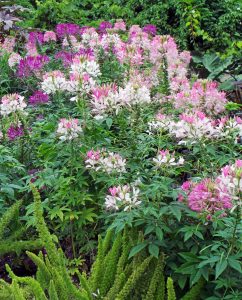
Cleome is a genus of about 170 species in the caper family (Capparaceae). Spider flower, Cleome hassleriana (sometimes referred to incorrectly as C. hasslerana or by the synonym C. spinosa) is a common annual flower from South America (Paraguay, Uruguay, Argentina and southern Brazil) that also goes by other common names including spider legs and grandfather’s whiskers. The common name of spider flower comes from the appearance of the long, thread-like stamens of the individual flowers and the elongate seedpods that develop below the blooming flowers. It has been a garden favorite since the 1800’s.
This tender annual grows quickly from seed to form tall, strong stems up to 6 feet tall from a stout taproot. Plants branch readily, and given enough space, can grow as wide as they are tall. The alternate leaves are palmately compound with 5-7 leaflets tapered at the base (although the leaves on the upper parts of the stems are smaller and simple). There are prickles on the midrib on the underside of the leaf and a pair of small spiny stipules at the base of each leaf petiole (some varieties are thornier than others), as well as glandular pubescence, so the aromatic foliage is slightly sticky with exudate and a foetid smell from the glandular hairs. Many people suggest the plants have a slight skunk-like scent. The lower leaves often fall toward the end of the season.

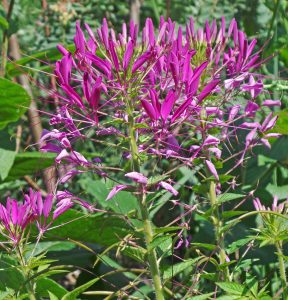
Plants bloom from early summer until frost in a dense, 6-8 inch wide, ever-lengthening terminal inflorescence (a raceme). Each 1–1½” wide individual flower on a 2-inch pedicel has 4 reflexed light green sepals, 4 clawed petals and 6 erect to spreading stamens that grow to 3-inches long with yellow-orange anthers. The petals may be white, pink, rose or purple. The flowers may be visited by hummingbirds, hummingbird moths, many types of bees and butterflies. Bats are thought to be the main pollinator in its native tropical habitat. Many types have no noticeable fragrance, while others are very fragrant, often described as a musky, sweet and pungent, or spicy scent. Cleome can be an excellent, striking cut flower if the scent is not considered disagreeable.

Each flower is replaced by a seedpod (an elongate, cylindrical 2-valved fruit filled with numerous seeds) that develops on a long narrow stipe as bloom progresses upward on the flower stalk. Wait until seed pods start to yellow if collecting seed; dry seed pods shatter read. Once the pods dry, they pop open to release the small round brown seeds. Cleome often self-seeds readily, although cultivars may not produce progeny the same as the parent plant (and after several generations all end up a pale pink color). Removing the seedpods as they develop can help limit self-seeding or spreading thick mulch over the area the following spring will reduce volunteers. Although this plant self-seeds prolifically and has naturalized in some areas, it is generally not considered invasive as it rarely persists in undisturbed areas.

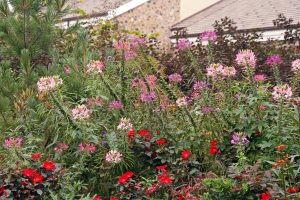
Cleome is a nice addition to annual beds, can be combined with perennials in mixed beds, or used in a mass planting for a dramatic effect. When planted in mass, they can look like a blooming shrub, and works well to fill empty spaces in a young planting until the shrubs mature. Depending on the variety, they may be best at the back of a border or in the center of island beds (for the tall types) or interspersed throughout (for shorter cultivars) a planting. This plant works well in cottage gardens, combined with other upright flowers such as Liatris, cosmos and snapdragons, and tall types could be used as a temporary summer hedge or as a screen along a fence. Go for a monochromatic effect by planting purple cleome with violet salvia and two-toned or lavender petunias in front. Or use it as an airy foil to contrast with the bold flowers of cosmos or purple coneflowers in similar colors. With its exotic appearance, cleome also combines well with hibiscus, bananas, and other bold foliage and flowers for a tropical feel. Shorter cultivars can be used in large containers.

Spider flower grows best in full sun in moist, well-drained soil. Although it tolerates dry conditions, watering will promote better growth and flowering but overwatering and overfertilizing causes leggy growth. Staking is usually not necessary, except in windy locations. Pinching them back when young will promote a shorter, bushier plant, otherwise they tend to be upright and columnar. Because the plants are somewhat spiny and sticky, you may want to wear gloves when handling the plants. Cleome has few insects or disease problems and is generally not favored by deer or rabbits. Occasionally flea beetles or imported cabbageworm (Pieris rapae) caterpillars will feed on the foliage.
Start this annual indoors 6-8 weeks before the average date of last frost or seed directly in the garden after all danger of frost has passed. Seed must be cold stratified (just like they would be if they overwintered outside) first, press the seed into the soil without covering it (this plant requires light to germinate), then should germinate in a little over a week. Wait until the soil has warmed to plant in the garden, spacing the plants (or thin if self-seeded) at least a foot apart (up to 3 feet if you want a bushier plant). Self-seeded plants need to be thinned or all will be weak and spindly.
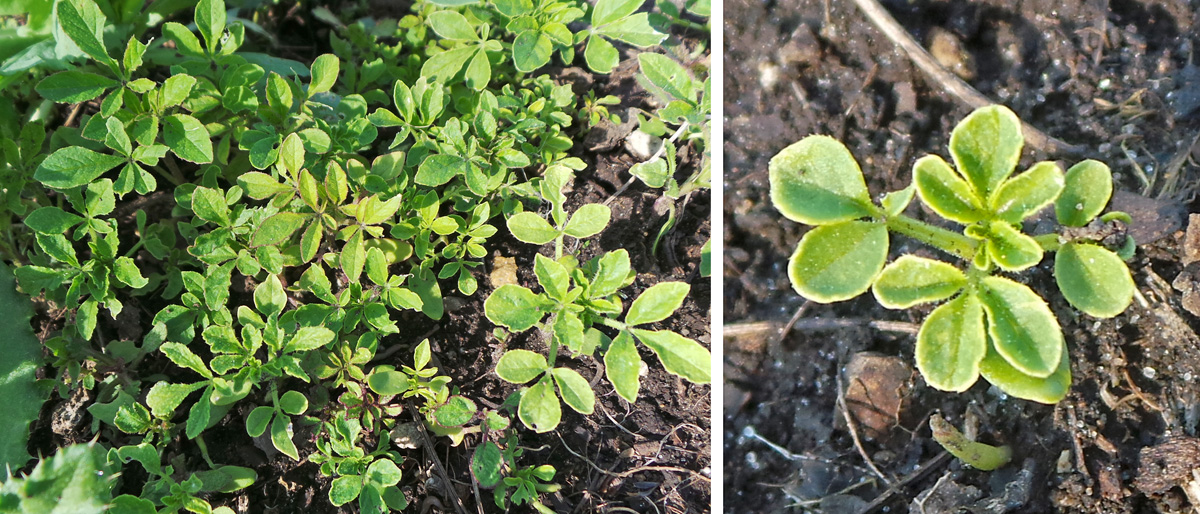
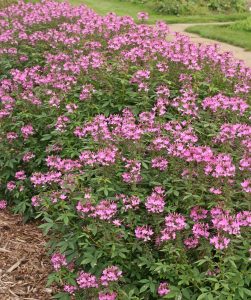
There are a number of cultivars of cleome, including
- ‘Helen Campbell’ – is a white-flowered cultivar which received the RHS Award of Garden Merit in 1993.
- ‘Linde Armstrong’ – is a very compact, thornless cultivar with pink flowers. This is an Athens Select plant (University of Georgia) with good heat tolerance that only grow 12-18” tall.
- ‘Queen’ – is a series which comes in white, rose, cherry and purple shades on 3-5 foot tall plants.
- Señorita Rosalita® – is thornless, odorless and sterile, with smaller purple-lavender flowers all along the stem (not just at the top) that don’t produce seeds and the foliage on the 12-18” tall plants is not sticky. Señorita Mi Amor® is the pink version.
-
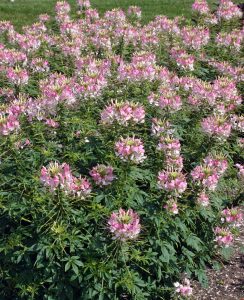
Cleome ‘Sparkler Blush’.
‘Sparkler’ – is a F1 hybrid series with 3-4 foot tall, very full and bushy plants. ‘Sparkler Blush’, with pink and white flowers, was a 2002 All-America Selections award winner. Other colors in the series are lavender, rose and white. - Spirit™ Series – a more compact (24-48” tall) and better branching series from Proven Winners includes Appleblossom (pale pink fading to white), Frost (white) and Violeta (pink-purple).
– Susan Mahr, University of Wisconsin – Madison





 Marigolds
Marigolds Create a Butterfly Garden
Create a Butterfly Garden Plant Flowers to Encourage Beneficial Insects
Plant Flowers to Encourage Beneficial Insects Forcing Bulbs
Forcing Bulbs


